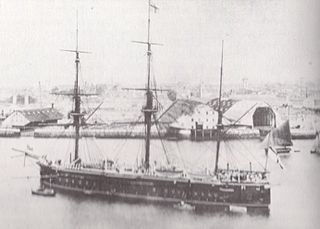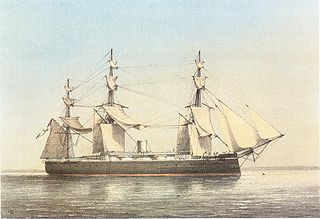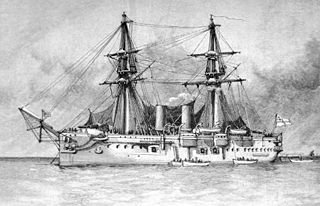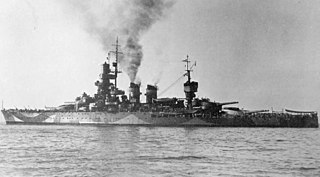
An ironclad is a steam-propelled warship protected by iron or steel armor plates, constructed from 1859 to the early 1890s. The ironclad was developed as a result of the vulnerability of wooden warships to explosive or incendiary shells. The first ironclad battleship, Gloire, was launched by the French Navy in November 1859 – narrowly pre-empting the British Royal Navy, though Britain built the first completely iron-hulled warships.

The Nelson class was a class of two battleships of the British Royal Navy, built shortly after, and under the terms of, the Washington Naval Treaty of 1922. They were the only British battleships built between the Revenge class and the King George V class, ordered in 1936.

HMS Queen Elizabeth was the lead ship of her class of five dreadnought battleships built for the Royal Navy in the early 1910s, and was often used as a flagship. She served in the First World War as part of the Grand Fleet, and participated in the inconclusive action of 19 August 1916. Her service during the war generally consisted of routine patrols and training in the North Sea. She and the other super-dreadnought battleships were the first of their type to be powered by oil instead of coal. Queen Elizabeth later served in several theatres during the Second World War, and was scrapped in 1948.

HMS Invincible was a Royal Navy Audacious-class ironclad battleship. She was built at the Napier shipyard and completed in 1870. Completed just 10 years after HMS Warrior, she still carried sails as well as a steam engine.

HMS Triumph was a broadside ironclad battleship of the Victorian era, the sister-ship of HMS Swiftsure. These two ships comprise the Swiftsure class of 1870.

Turret ships were a 19th-century type of warship, the earliest to have their guns mounted in a revolving gun turret, instead of a broadside arrangement.

The eighth HMS Shannon was the first British armoured cruiser. She was the last Royal Navy ironclad to be built which had a propeller that could be hoisted out of the water to reduce drag when she was under sail, and the first to have an armoured deck.

HMS Swiftsure was one of three Minotaur-class light cruisers built for the Royal Navy during the Second World War. She was laid down by Vickers Armstrong at Newcastle upon Tyne on 22 September 1941, launched on 4 February 1943 by Lady Wake-Walker and commissioned on 22 June 1944. The first of a new Minotaur class, a development of the later Colony class with extra beam and a fifth twin 4 inch turret. Swiftsure was the last Royal Navy cruiser completed during World War II and was the first British cruiser designed around the concept of an operations room and modern radar, with sensor screens and communications positioned for efficient operation. During her service in the Pacific in 1945, she proved the most efficient anti-aircraft cruiser in the fleet and was the first Royal Navy cruiser with the Type 274 lock-and-follow radar targeting system for her main armament.

HMS Swiftsure was the lead ship of the Swiftsure class battleships built in the late Victorian era. Her sister-ship was HMS Triumph.

HMSZealous was one of the three ships forming the second group of wooden steam battleships selected in 1860 for conversion to ironclads. This was done in response to the perceived threat to Britain offered by the large French ironclad building programme. The ship was ordered to the West Coast of Canada after she was completed to represent British interests in the Eastern Pacific Ocean. Zealous became the flagship for the Pacific Station for six years until she was relieved in 1872. She was refitted upon her arrival and subsequently became the guard ship at Southampton until she was paid off in 1875. The ship was in reserve until she was sold for scrap in 1886.

The Lord Clyde-class ironclads were a pair of wooden-hulled armoured frigates built for the Royal Navy in the 1860s. They were designed by Sir Edward Reed and built to make use of the large stocks of seasoned timber available in the royal shipyards.

HMS Lord Warden was the second and last ship of the wooden-hulled Lord Clyde class of armoured frigates built for the Royal Navy (RN) during the 1860s. She and her sister ship, Lord Clyde, were the heaviest wooden ships ever built and were also the fastest steaming wooden ships. They were also the slowest-sailing ironclads in the RN.
HMS Repulse was the last wooden battleship constructed for the Royal Navy.

HMS Monarch was the first seagoing British warship to carry her guns in turrets, and the first British warship to carry guns of 12-inch (300 mm) calibre.

The Cerberus-class breastwork monitor was a pair of breastwork monitors built for the Royal Navy in the 1860s.

The Audacious-class ironclad battleships were designed by Sir Edward Reed at the request of the Board of Admiralty to serve as second-class battleships on distant foreign stations.

HMS Alexandra was a central battery ironclad of the Victorian Royal Navy, whose seagoing career was from 1877 to 1900. She spent much of her career as a flagship, and took part in operations to deter the Russian Empire's aggression against the Ottoman Empire in 1878 and the bombardment of Alexandria in 1882. She was affectionately known by her crew as Old Alex.

HMS Temeraire was an ironclad battleship of the Victorian Royal Navy which was unique in that she carried her main armament partly in the traditional broadside battery, and partly in barbettes on the upper deck.

The Andrea Doria class was a pair of dreadnought battleships built for the Royal Italian Navy between 1912 and 1916. The two ships—Andrea Doria and Duilio—were completed during World War I. The class was an incremental improvement over the preceding Conte di Cavour class. Like the earlier ships, Andrea Doria and Duilio were armed with a main battery of thirteen 305-millimeter (12.0 in) guns.

The Calypso class comprised two steam corvettes of the Royal Navy. Built for distant cruising in the heyday of the British Empire, they served with the fleet until the early twentieth century, when they became training ships. Remnants of both survive, after a fashion; HMS Calliope in the name of the naval reserve unit the ship once served, and HMS Calypso both in the name of a civilian charity and the more corporeal form of the hull, now awash in a cove off Newfoundland.


















